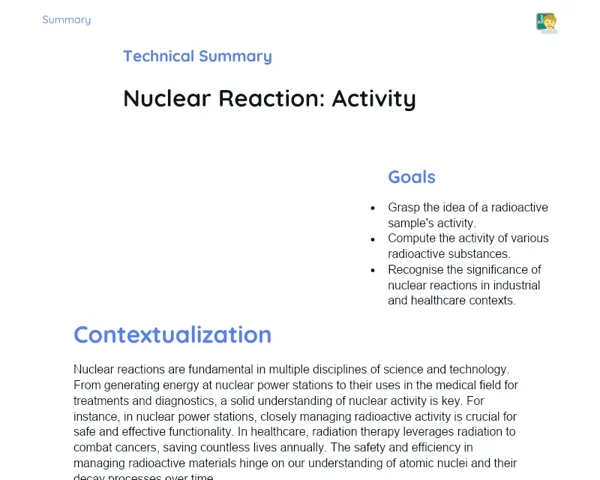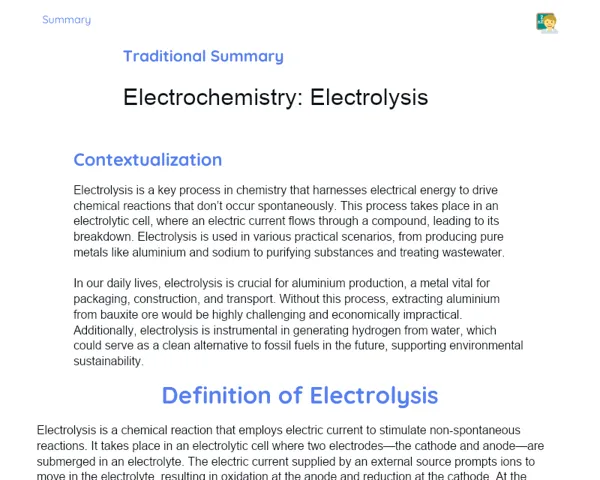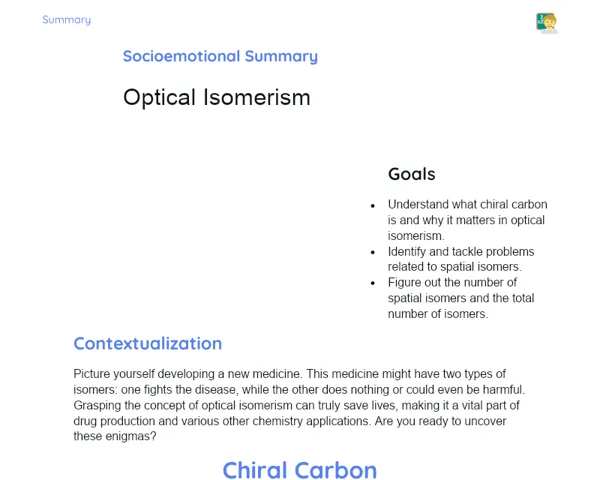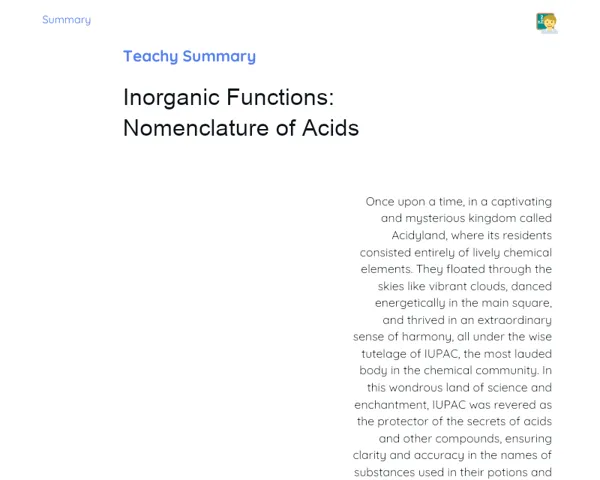Summary Tradisional | Equilibrium: pH and pOH
Contextualization
The concept of pH (potential hydrogen) is widely utilized across different sectors, from our industries to biology. pH measures the acidity or basicity of a solution and varies on a scale from 0 to 14. Solutions with a pH of less than 7 are regarded as acidic, while those with a pH above 7 are basic. A pH of 7 is neutral. This measurement is essential for managing chemical and biological processes, such as in agriculture where the soil's pH directly affects plant health, and in healthcare where maintaining blood pH between 7.35 and 7.45 is vital for proper bodily functions.
On the other hand, pOH is a complementary measure that indicates the hydroxide ion (OH-) concentration in a solution. The relationship between pH and pOH is defined by their sum, which is always 14 at 25°C. The ionization constant of water (Kw) is the product of the concentrations of H+ and OH- ions, and is a fixed value of 1 x 10^-14 at 25°C. Understanding these relationships and being able to calculate the pH and pOH of a solution is crucial for addressing ionic balance issues in both practical and theoretical scenarios.
To Remember!
Definition of pH and pOH
pH is a measure that indicates how acidic or basic a solution is, based on hydrogen ion (H+) concentration. The pH scale runs from 0 to 14, with values under 7 indicating acidity, those over 7 indicating basicity, and 7 being neutral, like pure water. The calculation formula for pH is pH = -log[H+], where [H+] is the molar concentration of hydrogen ions in the solution.
Conversely, pOH measures the hydroxide ion (OH-) concentration in a solution. Similar to pH, pOH also ranges from 0 to 14, where values below 7 suggest acidity and those above 7 denote basicity. The formula for pOH is pOH = -log[OH-], where [OH-] shows the molar concentration of hydroxide ions in the solution.
The sum of the pH and pOH of a solution is always 14 at 25°C, which is critical for understanding ionic equilibrium in solutions. Thus, knowing either the pH or pOH allows us to easily calculate the other using the relationship pH + pOH = 14.
-
pH measures the concentration of H+ ions in a solution.
-
pOH measures the concentration of OH- ions in a solution.
-
The sum of pH and pOH is always 14 at 25°C.
pH Scale
The pH scale is a valuable tool for categorizing aqueous solutions regarding acidity or basicity. It spans from 0 to 14 and is logarithmic, meaning each unit change represents a tenfold alteration in hydrogen ion concentration. For instance, a solution with a pH of 3 is ten times more acidic than one with a pH of 4.
pH values under 7 indicate acidic solutions, common in substances like lemon juice (approximately pH 2) and vinegar (around pH 3). Values above 7 indicate basic solutions, such as bleach (about pH 12) and ammonia (approximately pH 11). A pH of 7 is neutral, found in pure water.
The pH scale is crucial for various practical applications, particularly in agriculture, where soil pH can significantly affect nutrient availability for crops. In medicine, it's important to maintain human blood pH between 7.35 and 7.45 for optimal body functioning.
-
The pH scale ranges from 0 to 14.
-
Below 7 indicates acidity, above 7 denotes basicity, and 7 is neutral.
-
The pH scale is logarithmic, with each unit representing a tenfold change in H+ concentration.
Formulas for Calculating pH and pOH
To determine the pH of a solution, use the formula pH = -log[H+], where [H+] signifies the molar concentration of hydrogen ions in the solution. This formula comes from the definition of pH as the negative logarithm of the concentration of H+ ions. For instance, if the concentration of H+ ions is 1 x 10^-3 M, the pH will be 3 (pH = -log(1 x 10^-3)).
To calculate the pOH of a solution, apply the formula pOH = -log[OH-], where [OH-] denotes the molar concentration of hydroxide ions in the solution. This formula functions analogously to that of pH but pertains to the concentration of OH- ions. For example, if [OH-] is 2 x 10^-4 M, the pOH will be approximately 3.7 (pOH = -log(2 x 10^-4)).
The connection between pH and pOH is established by the equation pH + pOH = 14 at 25°C. This means that if we have the pH of a solution, we can easily derive the pOH and vice versa. If, say, the pH is 5, then the pOH would be 9 (14 - 5 = 9).
-
Formula for calculating pH: pH = -log[H+].
-
Formula for calculating pOH: pOH = -log[OH-].
-
The sum of pH and pOH is always 14 at 25°C.
Ionization Constant of Water (Kw)
Pure water undergoes slight self-ionization, creating hydrogen ions (H+) and hydroxide ions (OH-). The ionization constant of water (Kw) is the product of the concentrations of these ions in pure water at 25°C, expressed as Kw = [H+][OH-] = 1 x 10^-14. This constant is key to grasping ionic equilibrium in aqueous solutions.
The relationship Kw = [H+][OH-] = 1 x 10^-14 allows us to calculate the concentration of either H+ or OH- ions if we know the concentration of the other. For example, if the concentration of H+ ions in a solution is 1 x 10^-5 M, the concentration of OH- ions will be 1 x 10^-9 M to keep Kw constant.
This constant clarifies why pH and pOH always total 14 at 25°C. Since pH = -log[H+] and pOH = -log[OH-], the sum of the negative logarithms of both H+ and OH- concentrations gives us 14, illustrating the ionization constant of water.
-
Kw is the ionization constant of water.
-
Kw = [H+][OH-] = 1 x 10^-14 at 25°C.
-
Kw helps in calculating the concentration of either H+ or OH- if we know the other.
Key Terms
-
pH: Measure of the concentration of hydrogen ions (H+) in a solution.
-
pOH: Measure of the concentration of hydroxide ions (OH-) in a solution.
-
Ionic Equilibrium: A state where the concentration of H+ and OH- ions in a solution is such that their product remains constant.
-
Ionization Constant of Water (Kw): The product of the concentrations of H+ and OH- ions in pure water at 25°C, where Kw = 1 x 10^-14.
-
pH Scale: A tool that ranges from 0 to 14 categorizing solutions as acidic, basic, or neutral.
-
Logarithm (log): A mathematical function used to compute pH and pOH; it expresses how many times one number must be multiplied by itself to obtain another number.
Important Conclusions
In this lesson, we explored the foundational concepts of pH and pOH, clarifying their definitions and the relationship between them. We learned that pH indicates how acidic or basic a solution is, while pOH relates to hydroxide ion concentration. The sum of pH and pOH is always 14 at 25°C, allowing us to calculate one from the other. Additionally, we discussed the significance of the ionization constant of water (Kw) and its link to ionic equilibrium in aqueous solutions.
We looked at the pH scale, which runs from 0 to 14, categorizing solutions as acidic, basic, or neutral. We presented formulas for calculating pH and pOH, and illustrated their application through practical examples. These calculations are vital for tackling ionic equilibrium challenges in diverse practical contexts, from agriculture to healthcare.
Grasping these concepts is important across various academic fields and everyday situations. We encourage students to dive deeper into this topic, as mastering these calculations can help solve real-world problems and understand crucial chemical and biological processes.
Study Tips
-
Regularly review the calculation formulas for pH and pOH (pH = -log[H+] and pOH = -log[OH-]) and practice with various concentrations of H+ and OH- ions.
-
Study the relationship between pH, pOH, and the ionization constant of water (Kw = [H+][OH-] = 1 x 10^-14) to strengthen the understanding of ionic equilibrium.
-
Use additional resources, such as educational videos and hands-on activities, to visualize and apply the concepts in diverse contexts, aiding understanding and retention.



